Nursing Reflection: Emergency Department, Rolfe's Model Analysis, 2017
VerifiedAdded on 2020/03/16
|13
|4401
|79
Practical Assignment
AI Summary
This assignment presents a nursing reflection based on experiences in an emergency department, employing Rolfe's reflective model to analyze critical incidents and improve professional practice. The reflection begins with an introduction to various reflective models, highlighting Rolfe's model as a preferred method for continuous improvement. The author documents specific incidents, including challenges in training new nurses, issues with teamwork, and leadership struggles. The reflection includes journal entries detailing interactions with junior nurses, patient care scenarios, and the application of leadership principles from Stephen Covey's "The Seven Habits of Highly Effective People." The author then analyzes these situations, focusing on the importance of interprofessional collaboration and the application of social exchange theory to improve teamwork and patient outcomes. The analysis emphasizes the need for effective communication, shared goals, and mutual understanding to enhance the quality of care within the emergency department. The assignment provides insights into the challenges faced by nurses and strategies for fostering a collaborative and supportive work environment.
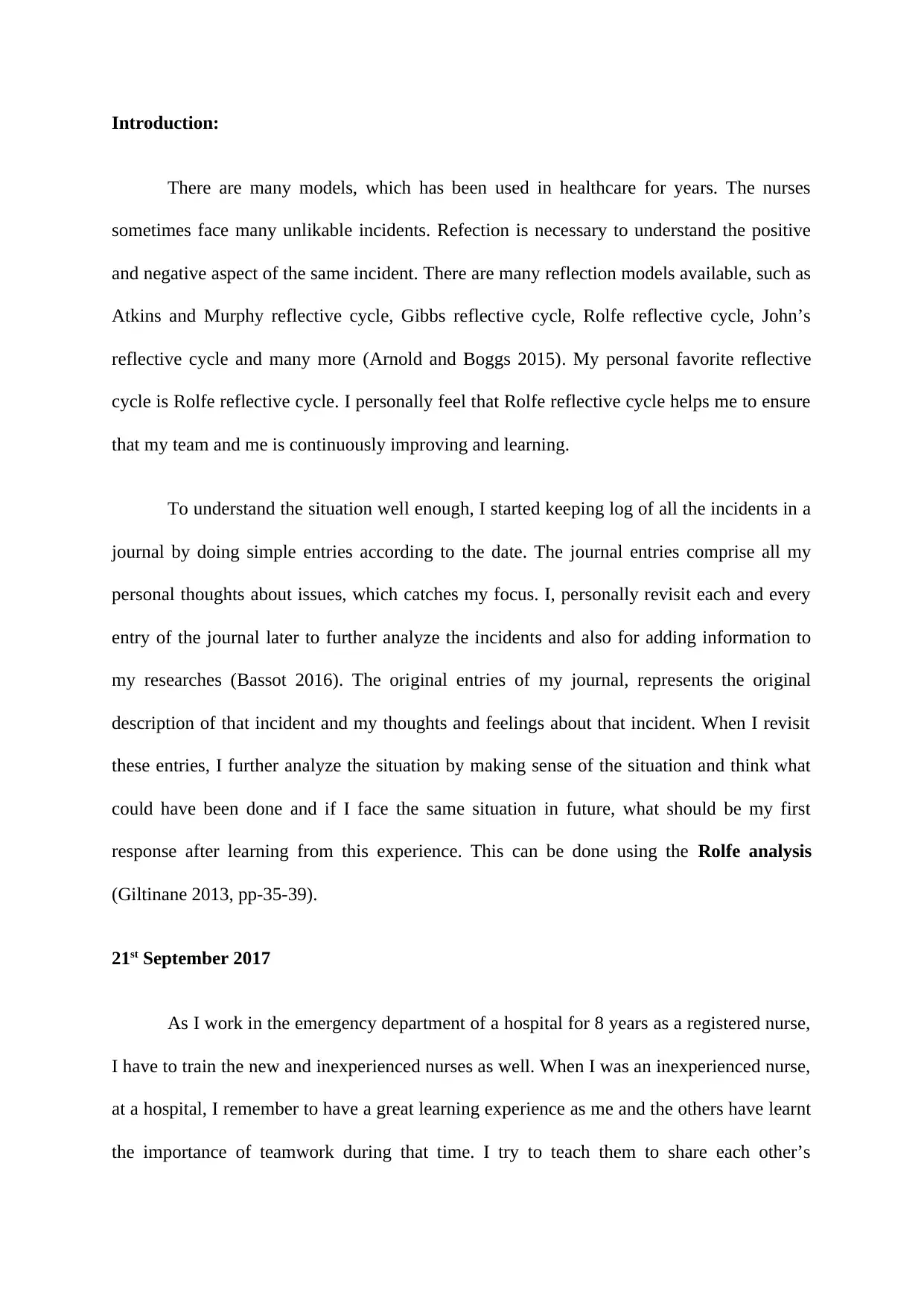
Introduction:
There are many models, which has been used in healthcare for years. The nurses
sometimes face many unlikable incidents. Refection is necessary to understand the positive
and negative aspect of the same incident. There are many reflection models available, such as
Atkins and Murphy reflective cycle, Gibbs reflective cycle, Rolfe reflective cycle, John’s
reflective cycle and many more (Arnold and Boggs 2015). My personal favorite reflective
cycle is Rolfe reflective cycle. I personally feel that Rolfe reflective cycle helps me to ensure
that my team and me is continuously improving and learning.
To understand the situation well enough, I started keeping log of all the incidents in a
journal by doing simple entries according to the date. The journal entries comprise all my
personal thoughts about issues, which catches my focus. I, personally revisit each and every
entry of the journal later to further analyze the incidents and also for adding information to
my researches (Bassot 2016). The original entries of my journal, represents the original
description of that incident and my thoughts and feelings about that incident. When I revisit
these entries, I further analyze the situation by making sense of the situation and think what
could have been done and if I face the same situation in future, what should be my first
response after learning from this experience. This can be done using the Rolfe analysis
(Giltinane 2013, pp-35-39).
21st September 2017
As I work in the emergency department of a hospital for 8 years as a registered nurse,
I have to train the new and inexperienced nurses as well. When I was an inexperienced nurse,
at a hospital, I remember to have a great learning experience as me and the others have learnt
the importance of teamwork during that time. I try to teach them to share each other’s
There are many models, which has been used in healthcare for years. The nurses
sometimes face many unlikable incidents. Refection is necessary to understand the positive
and negative aspect of the same incident. There are many reflection models available, such as
Atkins and Murphy reflective cycle, Gibbs reflective cycle, Rolfe reflective cycle, John’s
reflective cycle and many more (Arnold and Boggs 2015). My personal favorite reflective
cycle is Rolfe reflective cycle. I personally feel that Rolfe reflective cycle helps me to ensure
that my team and me is continuously improving and learning.
To understand the situation well enough, I started keeping log of all the incidents in a
journal by doing simple entries according to the date. The journal entries comprise all my
personal thoughts about issues, which catches my focus. I, personally revisit each and every
entry of the journal later to further analyze the incidents and also for adding information to
my researches (Bassot 2016). The original entries of my journal, represents the original
description of that incident and my thoughts and feelings about that incident. When I revisit
these entries, I further analyze the situation by making sense of the situation and think what
could have been done and if I face the same situation in future, what should be my first
response after learning from this experience. This can be done using the Rolfe analysis
(Giltinane 2013, pp-35-39).
21st September 2017
As I work in the emergency department of a hospital for 8 years as a registered nurse,
I have to train the new and inexperienced nurses as well. When I was an inexperienced nurse,
at a hospital, I remember to have a great learning experience as me and the others have learnt
the importance of teamwork during that time. I try to teach them to share each other’s
Paraphrase This Document
Need a fresh take? Get an instant paraphrase of this document with our AI Paraphraser
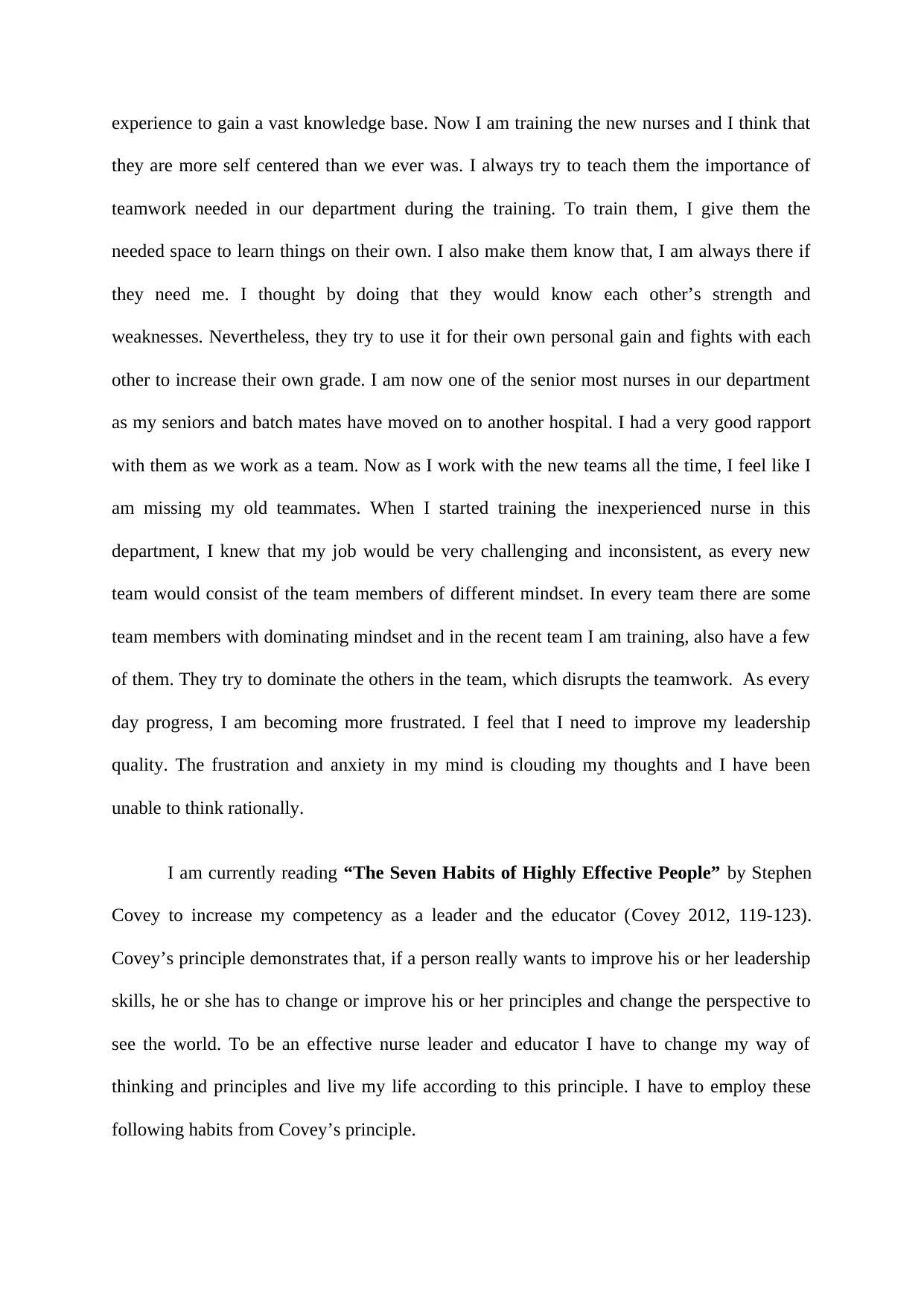
experience to gain a vast knowledge base. Now I am training the new nurses and I think that
they are more self centered than we ever was. I always try to teach them the importance of
teamwork needed in our department during the training. To train them, I give them the
needed space to learn things on their own. I also make them know that, I am always there if
they need me. I thought by doing that they would know each other’s strength and
weaknesses. Nevertheless, they try to use it for their own personal gain and fights with each
other to increase their own grade. I am now one of the senior most nurses in our department
as my seniors and batch mates have moved on to another hospital. I had a very good rapport
with them as we work as a team. Now as I work with the new teams all the time, I feel like I
am missing my old teammates. When I started training the inexperienced nurse in this
department, I knew that my job would be very challenging and inconsistent, as every new
team would consist of the team members of different mindset. In every team there are some
team members with dominating mindset and in the recent team I am training, also have a few
of them. They try to dominate the others in the team, which disrupts the teamwork. As every
day progress, I am becoming more frustrated. I feel that I need to improve my leadership
quality. The frustration and anxiety in my mind is clouding my thoughts and I have been
unable to think rationally.
I am currently reading “The Seven Habits of Highly Effective People” by Stephen
Covey to increase my competency as a leader and the educator (Covey 2012, 119-123).
Covey’s principle demonstrates that, if a person really wants to improve his or her leadership
skills, he or she has to change or improve his or her principles and change the perspective to
see the world. To be an effective nurse leader and educator I have to change my way of
thinking and principles and live my life according to this principle. I have to employ these
following habits from Covey’s principle.
they are more self centered than we ever was. I always try to teach them the importance of
teamwork needed in our department during the training. To train them, I give them the
needed space to learn things on their own. I also make them know that, I am always there if
they need me. I thought by doing that they would know each other’s strength and
weaknesses. Nevertheless, they try to use it for their own personal gain and fights with each
other to increase their own grade. I am now one of the senior most nurses in our department
as my seniors and batch mates have moved on to another hospital. I had a very good rapport
with them as we work as a team. Now as I work with the new teams all the time, I feel like I
am missing my old teammates. When I started training the inexperienced nurse in this
department, I knew that my job would be very challenging and inconsistent, as every new
team would consist of the team members of different mindset. In every team there are some
team members with dominating mindset and in the recent team I am training, also have a few
of them. They try to dominate the others in the team, which disrupts the teamwork. As every
day progress, I am becoming more frustrated. I feel that I need to improve my leadership
quality. The frustration and anxiety in my mind is clouding my thoughts and I have been
unable to think rationally.
I am currently reading “The Seven Habits of Highly Effective People” by Stephen
Covey to increase my competency as a leader and the educator (Covey 2012, 119-123).
Covey’s principle demonstrates that, if a person really wants to improve his or her leadership
skills, he or she has to change or improve his or her principles and change the perspective to
see the world. To be an effective nurse leader and educator I have to change my way of
thinking and principles and live my life according to this principle. I have to employ these
following habits from Covey’s principle.
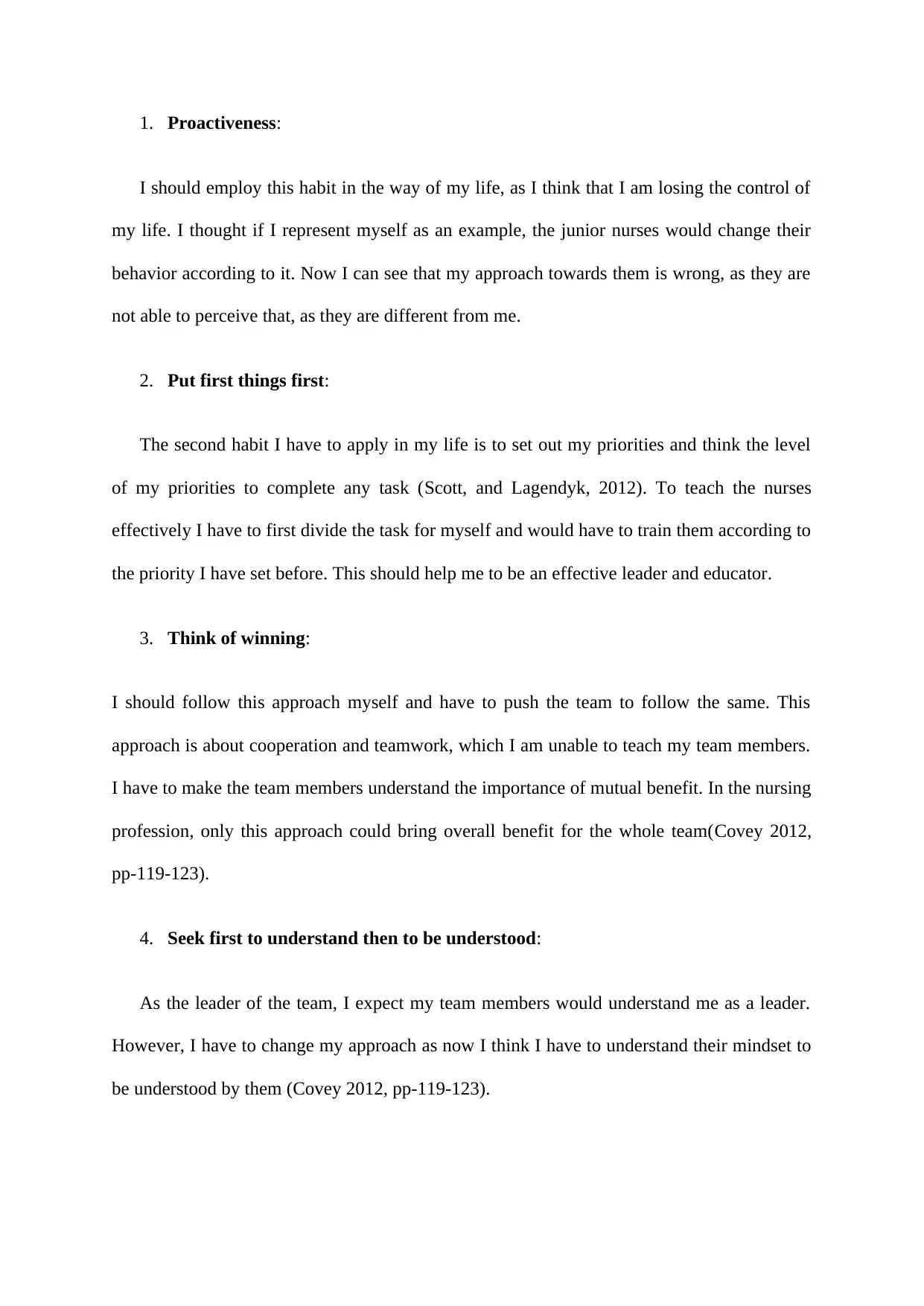
1. Proactiveness:
I should employ this habit in the way of my life, as I think that I am losing the control of
my life. I thought if I represent myself as an example, the junior nurses would change their
behavior according to it. Now I can see that my approach towards them is wrong, as they are
not able to perceive that, as they are different from me.
2. Put first things first:
The second habit I have to apply in my life is to set out my priorities and think the level
of my priorities to complete any task (Scott, and Lagendyk, 2012). To teach the nurses
effectively I have to first divide the task for myself and would have to train them according to
the priority I have set before. This should help me to be an effective leader and educator.
3. Think of winning:
I should follow this approach myself and have to push the team to follow the same. This
approach is about cooperation and teamwork, which I am unable to teach my team members.
I have to make the team members understand the importance of mutual benefit. In the nursing
profession, only this approach could bring overall benefit for the whole team(Covey 2012,
pp-119-123).
4. Seek first to understand then to be understood:
As the leader of the team, I expect my team members would understand me as a leader.
However, I have to change my approach as now I think I have to understand their mindset to
be understood by them (Covey 2012, pp-119-123).
I should employ this habit in the way of my life, as I think that I am losing the control of
my life. I thought if I represent myself as an example, the junior nurses would change their
behavior according to it. Now I can see that my approach towards them is wrong, as they are
not able to perceive that, as they are different from me.
2. Put first things first:
The second habit I have to apply in my life is to set out my priorities and think the level
of my priorities to complete any task (Scott, and Lagendyk, 2012). To teach the nurses
effectively I have to first divide the task for myself and would have to train them according to
the priority I have set before. This should help me to be an effective leader and educator.
3. Think of winning:
I should follow this approach myself and have to push the team to follow the same. This
approach is about cooperation and teamwork, which I am unable to teach my team members.
I have to make the team members understand the importance of mutual benefit. In the nursing
profession, only this approach could bring overall benefit for the whole team(Covey 2012,
pp-119-123).
4. Seek first to understand then to be understood:
As the leader of the team, I expect my team members would understand me as a leader.
However, I have to change my approach as now I think I have to understand their mindset to
be understood by them (Covey 2012, pp-119-123).
⊘ This is a preview!⊘
Do you want full access?
Subscribe today to unlock all pages.

Trusted by 1+ million students worldwide
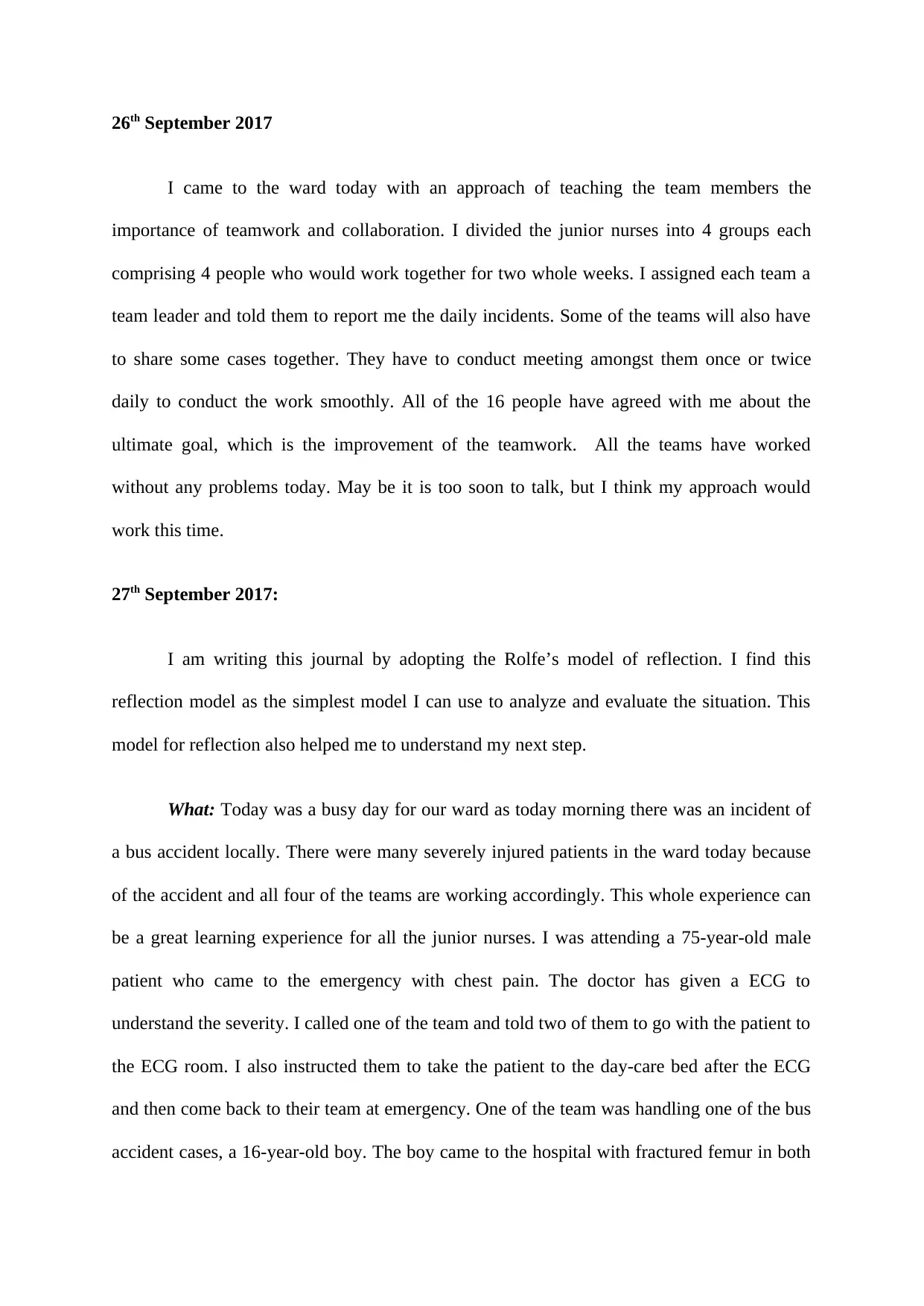
26th September 2017
I came to the ward today with an approach of teaching the team members the
importance of teamwork and collaboration. I divided the junior nurses into 4 groups each
comprising 4 people who would work together for two whole weeks. I assigned each team a
team leader and told them to report me the daily incidents. Some of the teams will also have
to share some cases together. They have to conduct meeting amongst them once or twice
daily to conduct the work smoothly. All of the 16 people have agreed with me about the
ultimate goal, which is the improvement of the teamwork. All the teams have worked
without any problems today. May be it is too soon to talk, but I think my approach would
work this time.
27th September 2017:
I am writing this journal by adopting the Rolfe’s model of reflection. I find this
reflection model as the simplest model I can use to analyze and evaluate the situation. This
model for reflection also helped me to understand my next step.
What: Today was a busy day for our ward as today morning there was an incident of
a bus accident locally. There were many severely injured patients in the ward today because
of the accident and all four of the teams are working accordingly. This whole experience can
be a great learning experience for all the junior nurses. I was attending a 75-year-old male
patient who came to the emergency with chest pain. The doctor has given a ECG to
understand the severity. I called one of the team and told two of them to go with the patient to
the ECG room. I also instructed them to take the patient to the day-care bed after the ECG
and then come back to their team at emergency. One of the team was handling one of the bus
accident cases, a 16-year-old boy. The boy came to the hospital with fractured femur in both
I came to the ward today with an approach of teaching the team members the
importance of teamwork and collaboration. I divided the junior nurses into 4 groups each
comprising 4 people who would work together for two whole weeks. I assigned each team a
team leader and told them to report me the daily incidents. Some of the teams will also have
to share some cases together. They have to conduct meeting amongst them once or twice
daily to conduct the work smoothly. All of the 16 people have agreed with me about the
ultimate goal, which is the improvement of the teamwork. All the teams have worked
without any problems today. May be it is too soon to talk, but I think my approach would
work this time.
27th September 2017:
I am writing this journal by adopting the Rolfe’s model of reflection. I find this
reflection model as the simplest model I can use to analyze and evaluate the situation. This
model for reflection also helped me to understand my next step.
What: Today was a busy day for our ward as today morning there was an incident of
a bus accident locally. There were many severely injured patients in the ward today because
of the accident and all four of the teams are working accordingly. This whole experience can
be a great learning experience for all the junior nurses. I was attending a 75-year-old male
patient who came to the emergency with chest pain. The doctor has given a ECG to
understand the severity. I called one of the team and told two of them to go with the patient to
the ECG room. I also instructed them to take the patient to the day-care bed after the ECG
and then come back to their team at emergency. One of the team was handling one of the bus
accident cases, a 16-year-old boy. The boy came to the hospital with fractured femur in both
Paraphrase This Document
Need a fresh take? Get an instant paraphrase of this document with our AI Paraphraser
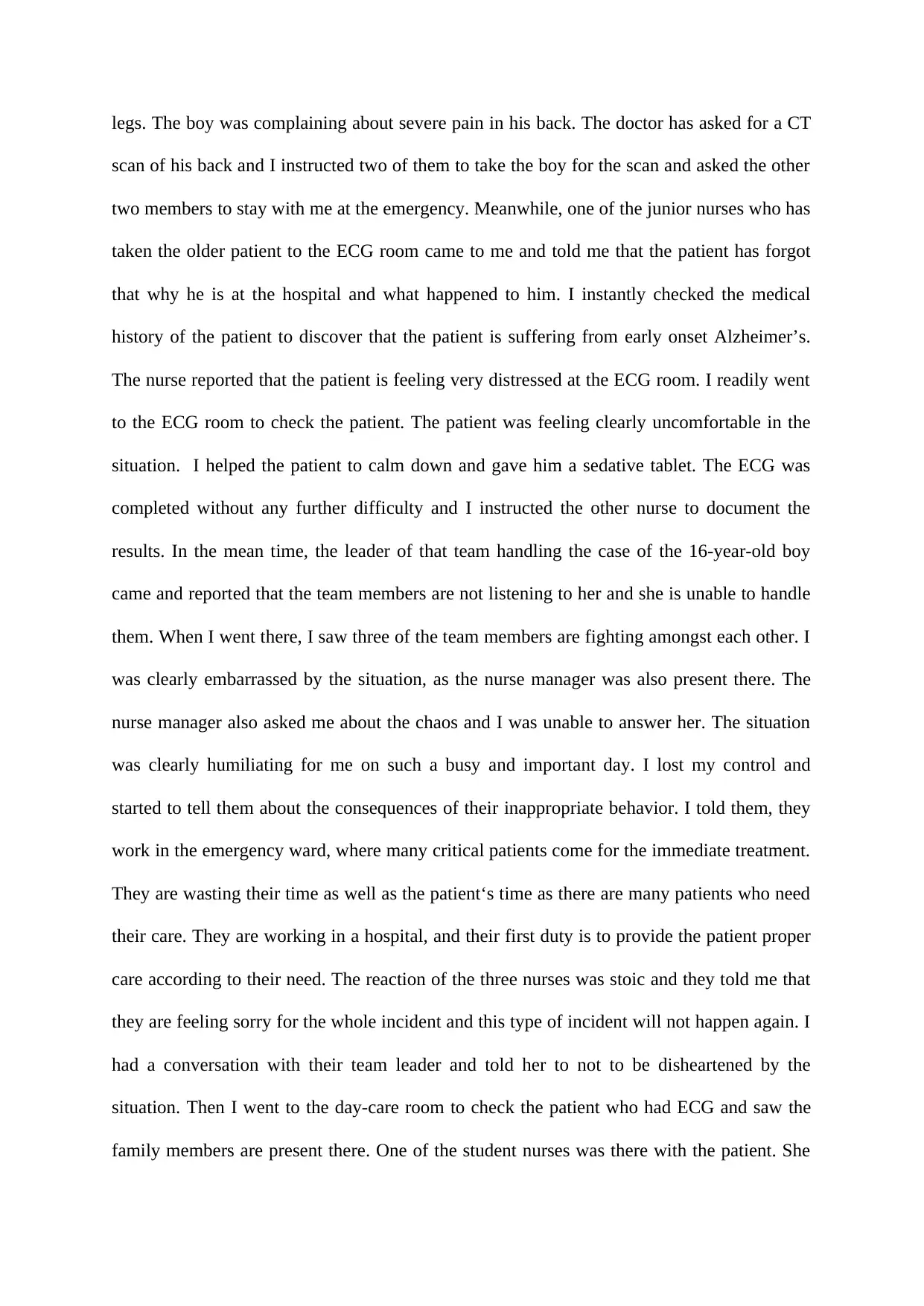
legs. The boy was complaining about severe pain in his back. The doctor has asked for a CT
scan of his back and I instructed two of them to take the boy for the scan and asked the other
two members to stay with me at the emergency. Meanwhile, one of the junior nurses who has
taken the older patient to the ECG room came to me and told me that the patient has forgot
that why he is at the hospital and what happened to him. I instantly checked the medical
history of the patient to discover that the patient is suffering from early onset Alzheimer’s.
The nurse reported that the patient is feeling very distressed at the ECG room. I readily went
to the ECG room to check the patient. The patient was feeling clearly uncomfortable in the
situation. I helped the patient to calm down and gave him a sedative tablet. The ECG was
completed without any further difficulty and I instructed the other nurse to document the
results. In the mean time, the leader of that team handling the case of the 16-year-old boy
came and reported that the team members are not listening to her and she is unable to handle
them. When I went there, I saw three of the team members are fighting amongst each other. I
was clearly embarrassed by the situation, as the nurse manager was also present there. The
nurse manager also asked me about the chaos and I was unable to answer her. The situation
was clearly humiliating for me on such a busy and important day. I lost my control and
started to tell them about the consequences of their inappropriate behavior. I told them, they
work in the emergency ward, where many critical patients come for the immediate treatment.
They are wasting their time as well as the patient‘s time as there are many patients who need
their care. They are working in a hospital, and their first duty is to provide the patient proper
care according to their need. The reaction of the three nurses was stoic and they told me that
they are feeling sorry for the whole incident and this type of incident will not happen again. I
had a conversation with their team leader and told her to not to be disheartened by the
situation. Then I went to the day-care room to check the patient who had ECG and saw the
family members are present there. One of the student nurses was there with the patient. She
scan of his back and I instructed two of them to take the boy for the scan and asked the other
two members to stay with me at the emergency. Meanwhile, one of the junior nurses who has
taken the older patient to the ECG room came to me and told me that the patient has forgot
that why he is at the hospital and what happened to him. I instantly checked the medical
history of the patient to discover that the patient is suffering from early onset Alzheimer’s.
The nurse reported that the patient is feeling very distressed at the ECG room. I readily went
to the ECG room to check the patient. The patient was feeling clearly uncomfortable in the
situation. I helped the patient to calm down and gave him a sedative tablet. The ECG was
completed without any further difficulty and I instructed the other nurse to document the
results. In the mean time, the leader of that team handling the case of the 16-year-old boy
came and reported that the team members are not listening to her and she is unable to handle
them. When I went there, I saw three of the team members are fighting amongst each other. I
was clearly embarrassed by the situation, as the nurse manager was also present there. The
nurse manager also asked me about the chaos and I was unable to answer her. The situation
was clearly humiliating for me on such a busy and important day. I lost my control and
started to tell them about the consequences of their inappropriate behavior. I told them, they
work in the emergency ward, where many critical patients come for the immediate treatment.
They are wasting their time as well as the patient‘s time as there are many patients who need
their care. They are working in a hospital, and their first duty is to provide the patient proper
care according to their need. The reaction of the three nurses was stoic and they told me that
they are feeling sorry for the whole incident and this type of incident will not happen again. I
had a conversation with their team leader and told her to not to be disheartened by the
situation. Then I went to the day-care room to check the patient who had ECG and saw the
family members are present there. One of the student nurses was there with the patient. She
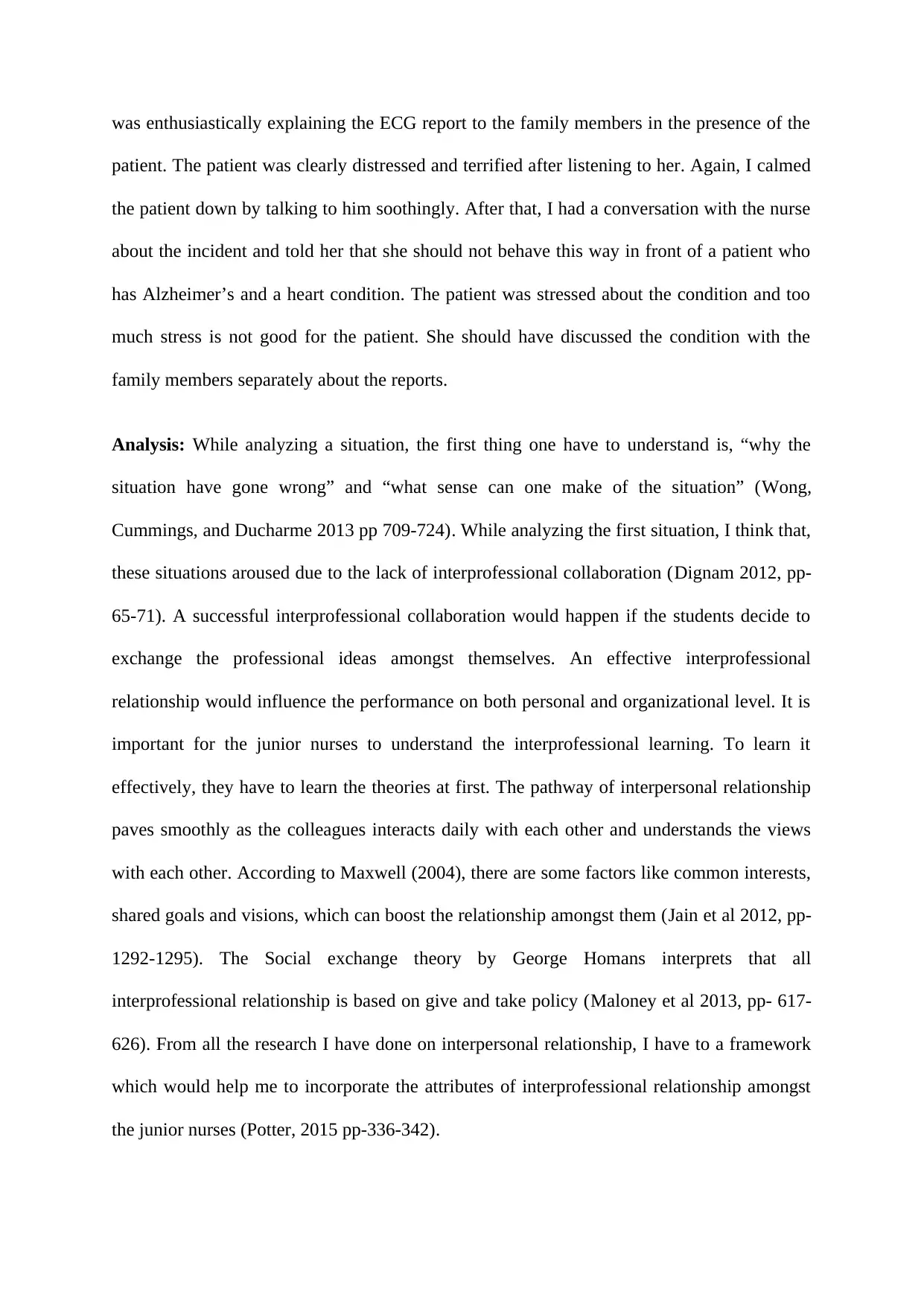
was enthusiastically explaining the ECG report to the family members in the presence of the
patient. The patient was clearly distressed and terrified after listening to her. Again, I calmed
the patient down by talking to him soothingly. After that, I had a conversation with the nurse
about the incident and told her that she should not behave this way in front of a patient who
has Alzheimer’s and a heart condition. The patient was stressed about the condition and too
much stress is not good for the patient. She should have discussed the condition with the
family members separately about the reports.
Analysis: While analyzing a situation, the first thing one have to understand is, “why the
situation have gone wrong” and “what sense can one make of the situation” (Wong,
Cummings, and Ducharme 2013 pp 709-724). While analyzing the first situation, I think that,
these situations aroused due to the lack of interprofessional collaboration (Dignam 2012, pp-
65-71). A successful interprofessional collaboration would happen if the students decide to
exchange the professional ideas amongst themselves. An effective interprofessional
relationship would influence the performance on both personal and organizational level. It is
important for the junior nurses to understand the interprofessional learning. To learn it
effectively, they have to learn the theories at first. The pathway of interpersonal relationship
paves smoothly as the colleagues interacts daily with each other and understands the views
with each other. According to Maxwell (2004), there are some factors like common interests,
shared goals and visions, which can boost the relationship amongst them (Jain et al 2012, pp-
1292-1295). The Social exchange theory by George Homans interprets that all
interprofessional relationship is based on give and take policy (Maloney et al 2013, pp- 617-
626). From all the research I have done on interpersonal relationship, I have to a framework
which would help me to incorporate the attributes of interprofessional relationship amongst
the junior nurses (Potter, 2015 pp-336-342).
patient. The patient was clearly distressed and terrified after listening to her. Again, I calmed
the patient down by talking to him soothingly. After that, I had a conversation with the nurse
about the incident and told her that she should not behave this way in front of a patient who
has Alzheimer’s and a heart condition. The patient was stressed about the condition and too
much stress is not good for the patient. She should have discussed the condition with the
family members separately about the reports.
Analysis: While analyzing a situation, the first thing one have to understand is, “why the
situation have gone wrong” and “what sense can one make of the situation” (Wong,
Cummings, and Ducharme 2013 pp 709-724). While analyzing the first situation, I think that,
these situations aroused due to the lack of interprofessional collaboration (Dignam 2012, pp-
65-71). A successful interprofessional collaboration would happen if the students decide to
exchange the professional ideas amongst themselves. An effective interprofessional
relationship would influence the performance on both personal and organizational level. It is
important for the junior nurses to understand the interprofessional learning. To learn it
effectively, they have to learn the theories at first. The pathway of interpersonal relationship
paves smoothly as the colleagues interacts daily with each other and understands the views
with each other. According to Maxwell (2004), there are some factors like common interests,
shared goals and visions, which can boost the relationship amongst them (Jain et al 2012, pp-
1292-1295). The Social exchange theory by George Homans interprets that all
interprofessional relationship is based on give and take policy (Maloney et al 2013, pp- 617-
626). From all the research I have done on interpersonal relationship, I have to a framework
which would help me to incorporate the attributes of interprofessional relationship amongst
the junior nurses (Potter, 2015 pp-336-342).
⊘ This is a preview!⊘
Do you want full access?
Subscribe today to unlock all pages.

Trusted by 1+ million students worldwide
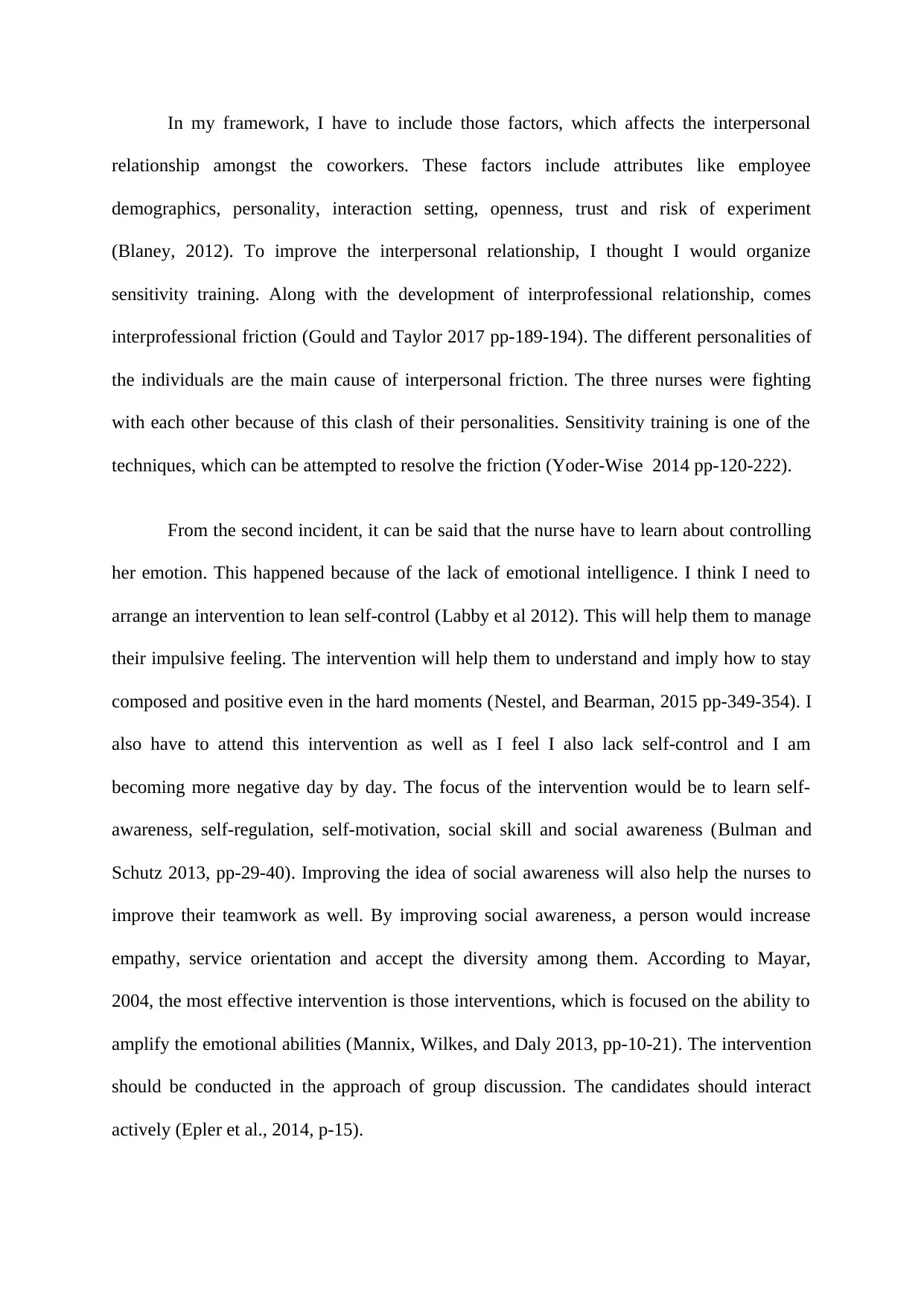
In my framework, I have to include those factors, which affects the interpersonal
relationship amongst the coworkers. These factors include attributes like employee
demographics, personality, interaction setting, openness, trust and risk of experiment
(Blaney, 2012). To improve the interpersonal relationship, I thought I would organize
sensitivity training. Along with the development of interprofessional relationship, comes
interprofessional friction (Gould and Taylor 2017 pp-189-194). The different personalities of
the individuals are the main cause of interpersonal friction. The three nurses were fighting
with each other because of this clash of their personalities. Sensitivity training is one of the
techniques, which can be attempted to resolve the friction (Yoder-Wise 2014 pp-120-222).
From the second incident, it can be said that the nurse have to learn about controlling
her emotion. This happened because of the lack of emotional intelligence. I think I need to
arrange an intervention to lean self-control (Labby et al 2012). This will help them to manage
their impulsive feeling. The intervention will help them to understand and imply how to stay
composed and positive even in the hard moments (Nestel, and Bearman, 2015 pp-349-354). I
also have to attend this intervention as well as I feel I also lack self-control and I am
becoming more negative day by day. The focus of the intervention would be to learn self-
awareness, self-regulation, self-motivation, social skill and social awareness (Bulman and
Schutz 2013, pp-29-40). Improving the idea of social awareness will also help the nurses to
improve their teamwork as well. By improving social awareness, a person would increase
empathy, service orientation and accept the diversity among them. According to Mayar,
2004, the most effective intervention is those interventions, which is focused on the ability to
amplify the emotional abilities (Mannix, Wilkes, and Daly 2013, pp-10-21). The intervention
should be conducted in the approach of group discussion. The candidates should interact
actively (Epler et al., 2014, p-15).
relationship amongst the coworkers. These factors include attributes like employee
demographics, personality, interaction setting, openness, trust and risk of experiment
(Blaney, 2012). To improve the interpersonal relationship, I thought I would organize
sensitivity training. Along with the development of interprofessional relationship, comes
interprofessional friction (Gould and Taylor 2017 pp-189-194). The different personalities of
the individuals are the main cause of interpersonal friction. The three nurses were fighting
with each other because of this clash of their personalities. Sensitivity training is one of the
techniques, which can be attempted to resolve the friction (Yoder-Wise 2014 pp-120-222).
From the second incident, it can be said that the nurse have to learn about controlling
her emotion. This happened because of the lack of emotional intelligence. I think I need to
arrange an intervention to lean self-control (Labby et al 2012). This will help them to manage
their impulsive feeling. The intervention will help them to understand and imply how to stay
composed and positive even in the hard moments (Nestel, and Bearman, 2015 pp-349-354). I
also have to attend this intervention as well as I feel I also lack self-control and I am
becoming more negative day by day. The focus of the intervention would be to learn self-
awareness, self-regulation, self-motivation, social skill and social awareness (Bulman and
Schutz 2013, pp-29-40). Improving the idea of social awareness will also help the nurses to
improve their teamwork as well. By improving social awareness, a person would increase
empathy, service orientation and accept the diversity among them. According to Mayar,
2004, the most effective intervention is those interventions, which is focused on the ability to
amplify the emotional abilities (Mannix, Wilkes, and Daly 2013, pp-10-21). The intervention
should be conducted in the approach of group discussion. The candidates should interact
actively (Epler et al., 2014, p-15).
Paraphrase This Document
Need a fresh take? Get an instant paraphrase of this document with our AI Paraphraser
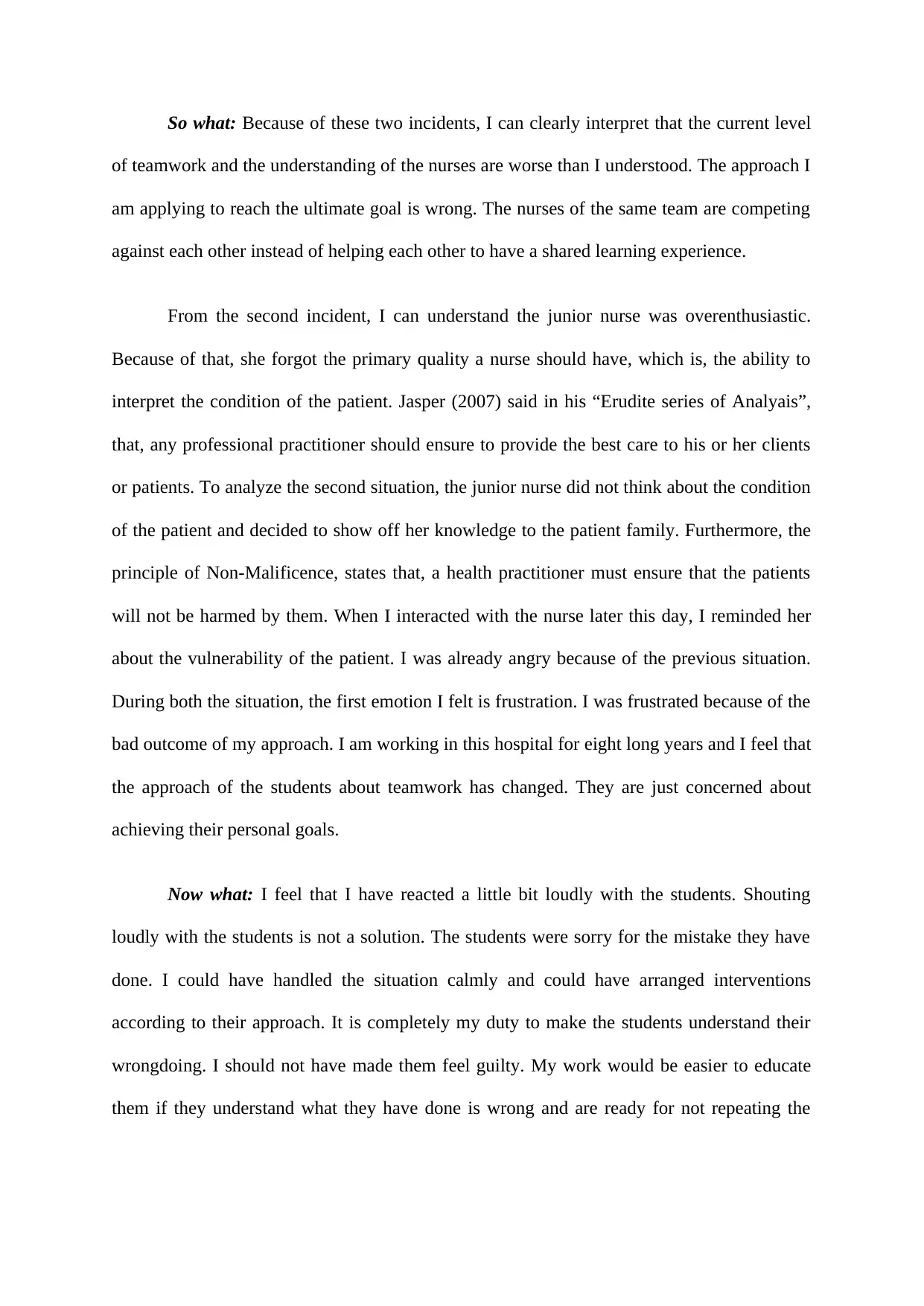
So what: Because of these two incidents, I can clearly interpret that the current level
of teamwork and the understanding of the nurses are worse than I understood. The approach I
am applying to reach the ultimate goal is wrong. The nurses of the same team are competing
against each other instead of helping each other to have a shared learning experience.
From the second incident, I can understand the junior nurse was overenthusiastic.
Because of that, she forgot the primary quality a nurse should have, which is, the ability to
interpret the condition of the patient. Jasper (2007) said in his “Erudite series of Analyais”,
that, any professional practitioner should ensure to provide the best care to his or her clients
or patients. To analyze the second situation, the junior nurse did not think about the condition
of the patient and decided to show off her knowledge to the patient family. Furthermore, the
principle of Non-Malificence, states that, a health practitioner must ensure that the patients
will not be harmed by them. When I interacted with the nurse later this day, I reminded her
about the vulnerability of the patient. I was already angry because of the previous situation.
During both the situation, the first emotion I felt is frustration. I was frustrated because of the
bad outcome of my approach. I am working in this hospital for eight long years and I feel that
the approach of the students about teamwork has changed. They are just concerned about
achieving their personal goals.
Now what: I feel that I have reacted a little bit loudly with the students. Shouting
loudly with the students is not a solution. The students were sorry for the mistake they have
done. I could have handled the situation calmly and could have arranged interventions
according to their approach. It is completely my duty to make the students understand their
wrongdoing. I should not have made them feel guilty. My work would be easier to educate
them if they understand what they have done is wrong and are ready for not repeating the
of teamwork and the understanding of the nurses are worse than I understood. The approach I
am applying to reach the ultimate goal is wrong. The nurses of the same team are competing
against each other instead of helping each other to have a shared learning experience.
From the second incident, I can understand the junior nurse was overenthusiastic.
Because of that, she forgot the primary quality a nurse should have, which is, the ability to
interpret the condition of the patient. Jasper (2007) said in his “Erudite series of Analyais”,
that, any professional practitioner should ensure to provide the best care to his or her clients
or patients. To analyze the second situation, the junior nurse did not think about the condition
of the patient and decided to show off her knowledge to the patient family. Furthermore, the
principle of Non-Malificence, states that, a health practitioner must ensure that the patients
will not be harmed by them. When I interacted with the nurse later this day, I reminded her
about the vulnerability of the patient. I was already angry because of the previous situation.
During both the situation, the first emotion I felt is frustration. I was frustrated because of the
bad outcome of my approach. I am working in this hospital for eight long years and I feel that
the approach of the students about teamwork has changed. They are just concerned about
achieving their personal goals.
Now what: I feel that I have reacted a little bit loudly with the students. Shouting
loudly with the students is not a solution. The students were sorry for the mistake they have
done. I could have handled the situation calmly and could have arranged interventions
according to their approach. It is completely my duty to make the students understand their
wrongdoing. I should not have made them feel guilty. My work would be easier to educate
them if they understand what they have done is wrong and are ready for not repeating the
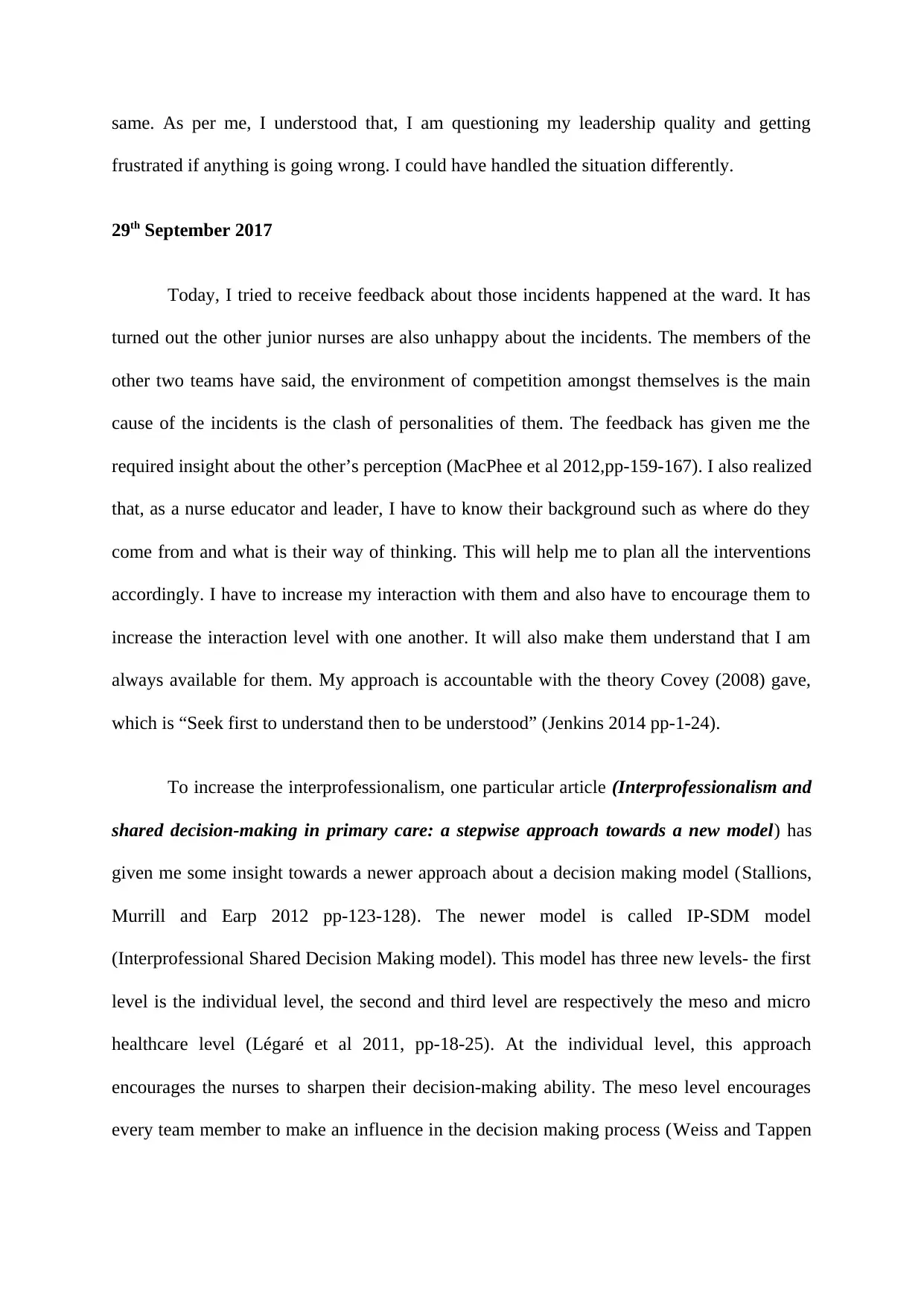
same. As per me, I understood that, I am questioning my leadership quality and getting
frustrated if anything is going wrong. I could have handled the situation differently.
29th September 2017
Today, I tried to receive feedback about those incidents happened at the ward. It has
turned out the other junior nurses are also unhappy about the incidents. The members of the
other two teams have said, the environment of competition amongst themselves is the main
cause of the incidents is the clash of personalities of them. The feedback has given me the
required insight about the other’s perception (MacPhee et al 2012,pp-159-167). I also realized
that, as a nurse educator and leader, I have to know their background such as where do they
come from and what is their way of thinking. This will help me to plan all the interventions
accordingly. I have to increase my interaction with them and also have to encourage them to
increase the interaction level with one another. It will also make them understand that I am
always available for them. My approach is accountable with the theory Covey (2008) gave,
which is “Seek first to understand then to be understood” (Jenkins 2014 pp-1-24).
To increase the interprofessionalism, one particular article (Interprofessionalism and
shared decision-making in primary care: a stepwise approach towards a new model) has
given me some insight towards a newer approach about a decision making model (Stallions,
Murrill and Earp 2012 pp-123-128). The newer model is called IP-SDM model
(Interprofessional Shared Decision Making model). This model has three new levels- the first
level is the individual level, the second and third level are respectively the meso and micro
healthcare level (Légaré et al 2011, pp-18-25). At the individual level, this approach
encourages the nurses to sharpen their decision-making ability. The meso level encourages
every team member to make an influence in the decision making process (Weiss and Tappen
frustrated if anything is going wrong. I could have handled the situation differently.
29th September 2017
Today, I tried to receive feedback about those incidents happened at the ward. It has
turned out the other junior nurses are also unhappy about the incidents. The members of the
other two teams have said, the environment of competition amongst themselves is the main
cause of the incidents is the clash of personalities of them. The feedback has given me the
required insight about the other’s perception (MacPhee et al 2012,pp-159-167). I also realized
that, as a nurse educator and leader, I have to know their background such as where do they
come from and what is their way of thinking. This will help me to plan all the interventions
accordingly. I have to increase my interaction with them and also have to encourage them to
increase the interaction level with one another. It will also make them understand that I am
always available for them. My approach is accountable with the theory Covey (2008) gave,
which is “Seek first to understand then to be understood” (Jenkins 2014 pp-1-24).
To increase the interprofessionalism, one particular article (Interprofessionalism and
shared decision-making in primary care: a stepwise approach towards a new model) has
given me some insight towards a newer approach about a decision making model (Stallions,
Murrill and Earp 2012 pp-123-128). The newer model is called IP-SDM model
(Interprofessional Shared Decision Making model). This model has three new levels- the first
level is the individual level, the second and third level are respectively the meso and micro
healthcare level (Légaré et al 2011, pp-18-25). At the individual level, this approach
encourages the nurses to sharpen their decision-making ability. The meso level encourages
every team member to make an influence in the decision making process (Weiss and Tappen
⊘ This is a preview!⊘
Do you want full access?
Subscribe today to unlock all pages.

Trusted by 1+ million students worldwide
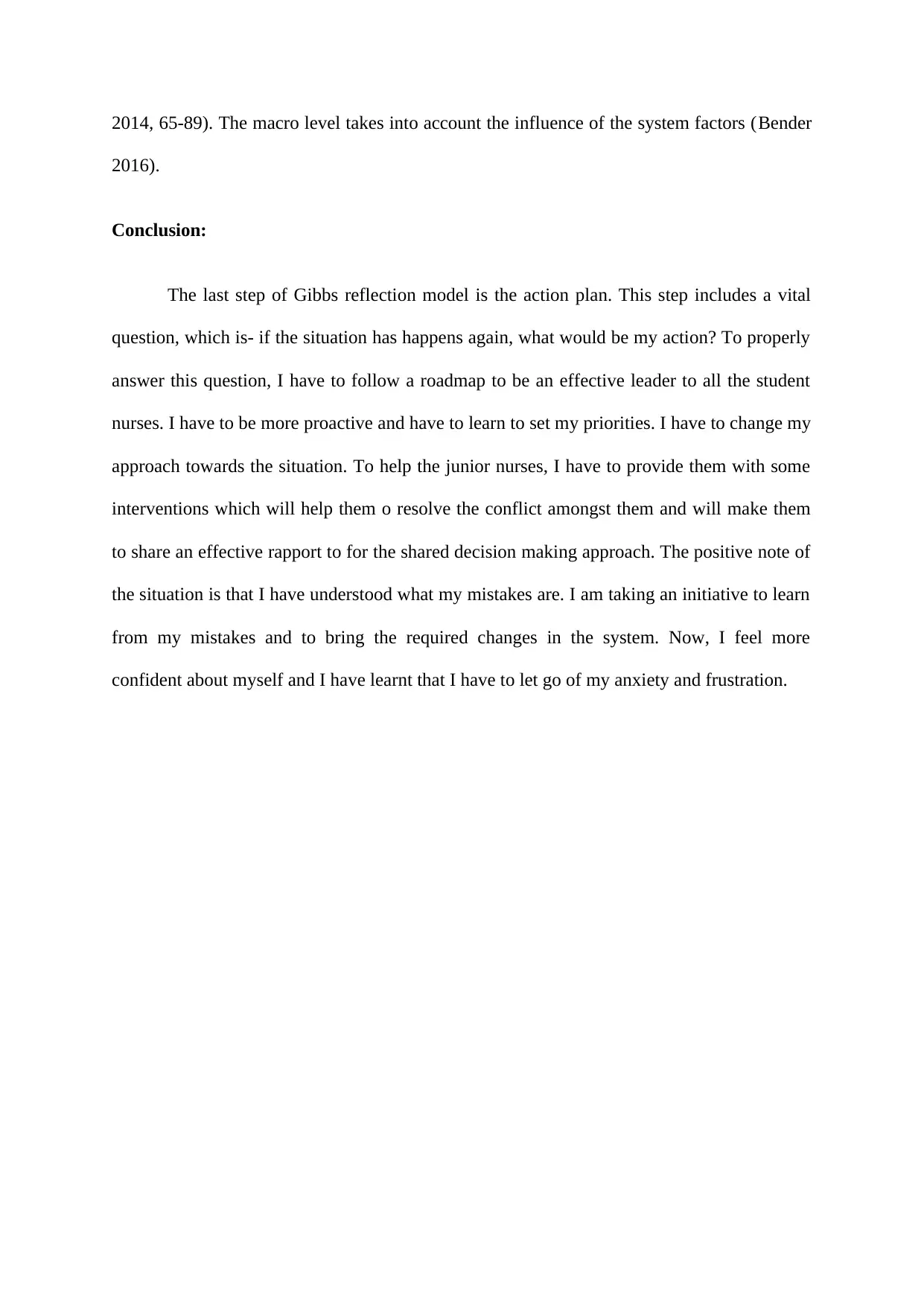
2014, 65-89). The macro level takes into account the influence of the system factors (Bender
2016).
Conclusion:
The last step of Gibbs reflection model is the action plan. This step includes a vital
question, which is- if the situation has happens again, what would be my action? To properly
answer this question, I have to follow a roadmap to be an effective leader to all the student
nurses. I have to be more proactive and have to learn to set my priorities. I have to change my
approach towards the situation. To help the junior nurses, I have to provide them with some
interventions which will help them o resolve the conflict amongst them and will make them
to share an effective rapport to for the shared decision making approach. The positive note of
the situation is that I have understood what my mistakes are. I am taking an initiative to learn
from my mistakes and to bring the required changes in the system. Now, I feel more
confident about myself and I have learnt that I have to let go of my anxiety and frustration.
2016).
Conclusion:
The last step of Gibbs reflection model is the action plan. This step includes a vital
question, which is- if the situation has happens again, what would be my action? To properly
answer this question, I have to follow a roadmap to be an effective leader to all the student
nurses. I have to be more proactive and have to learn to set my priorities. I have to change my
approach towards the situation. To help the junior nurses, I have to provide them with some
interventions which will help them o resolve the conflict amongst them and will make them
to share an effective rapport to for the shared decision making approach. The positive note of
the situation is that I have understood what my mistakes are. I am taking an initiative to learn
from my mistakes and to bring the required changes in the system. Now, I feel more
confident about myself and I have learnt that I have to let go of my anxiety and frustration.
Paraphrase This Document
Need a fresh take? Get an instant paraphrase of this document with our AI Paraphraser
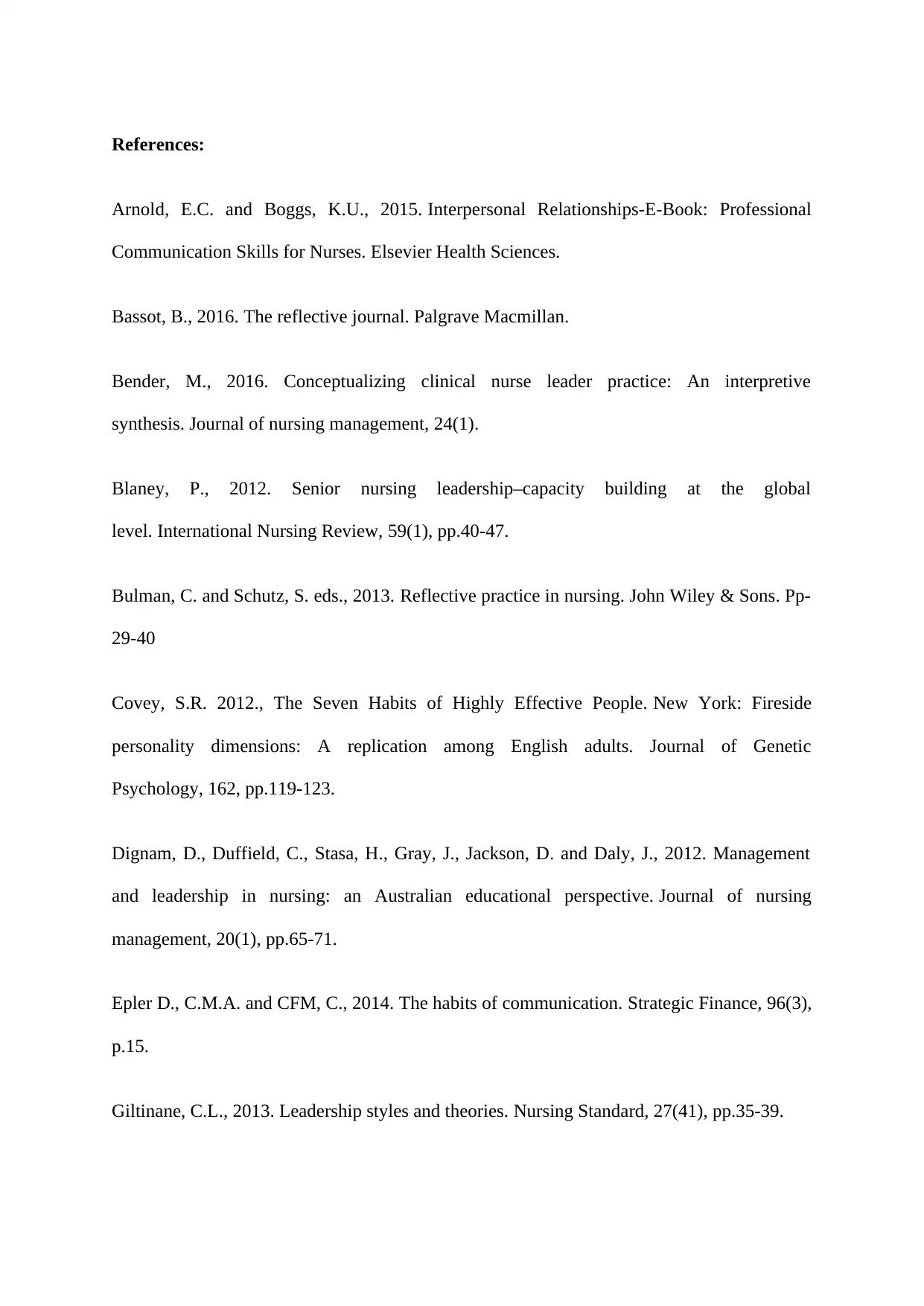
References:
Arnold, E.C. and Boggs, K.U., 2015. Interpersonal Relationships-E-Book: Professional
Communication Skills for Nurses. Elsevier Health Sciences.
Bassot, B., 2016. The reflective journal. Palgrave Macmillan.
Bender, M., 2016. Conceptualizing clinical nurse leader practice: An interpretive
synthesis. Journal of nursing management, 24(1).
Blaney, P., 2012. Senior nursing leadership–capacity building at the global
level. International Nursing Review, 59(1), pp.40-47.
Bulman, C. and Schutz, S. eds., 2013. Reflective practice in nursing. John Wiley & Sons. Pp-
29-40
Covey, S.R. 2012., The Seven Habits of Highly Effective People. New York: Fireside
personality dimensions: A replication among English adults. Journal of Genetic
Psychology, 162, pp.119-123.
Dignam, D., Duffield, C., Stasa, H., Gray, J., Jackson, D. and Daly, J., 2012. Management
and leadership in nursing: an Australian educational perspective. Journal of nursing
management, 20(1), pp.65-71.
Epler D., C.M.A. and CFM, C., 2014. The habits of communication. Strategic Finance, 96(3),
p.15.
Giltinane, C.L., 2013. Leadership styles and theories. Nursing Standard, 27(41), pp.35-39.
Arnold, E.C. and Boggs, K.U., 2015. Interpersonal Relationships-E-Book: Professional
Communication Skills for Nurses. Elsevier Health Sciences.
Bassot, B., 2016. The reflective journal. Palgrave Macmillan.
Bender, M., 2016. Conceptualizing clinical nurse leader practice: An interpretive
synthesis. Journal of nursing management, 24(1).
Blaney, P., 2012. Senior nursing leadership–capacity building at the global
level. International Nursing Review, 59(1), pp.40-47.
Bulman, C. and Schutz, S. eds., 2013. Reflective practice in nursing. John Wiley & Sons. Pp-
29-40
Covey, S.R. 2012., The Seven Habits of Highly Effective People. New York: Fireside
personality dimensions: A replication among English adults. Journal of Genetic
Psychology, 162, pp.119-123.
Dignam, D., Duffield, C., Stasa, H., Gray, J., Jackson, D. and Daly, J., 2012. Management
and leadership in nursing: an Australian educational perspective. Journal of nursing
management, 20(1), pp.65-71.
Epler D., C.M.A. and CFM, C., 2014. The habits of communication. Strategic Finance, 96(3),
p.15.
Giltinane, C.L., 2013. Leadership styles and theories. Nursing Standard, 27(41), pp.35-39.
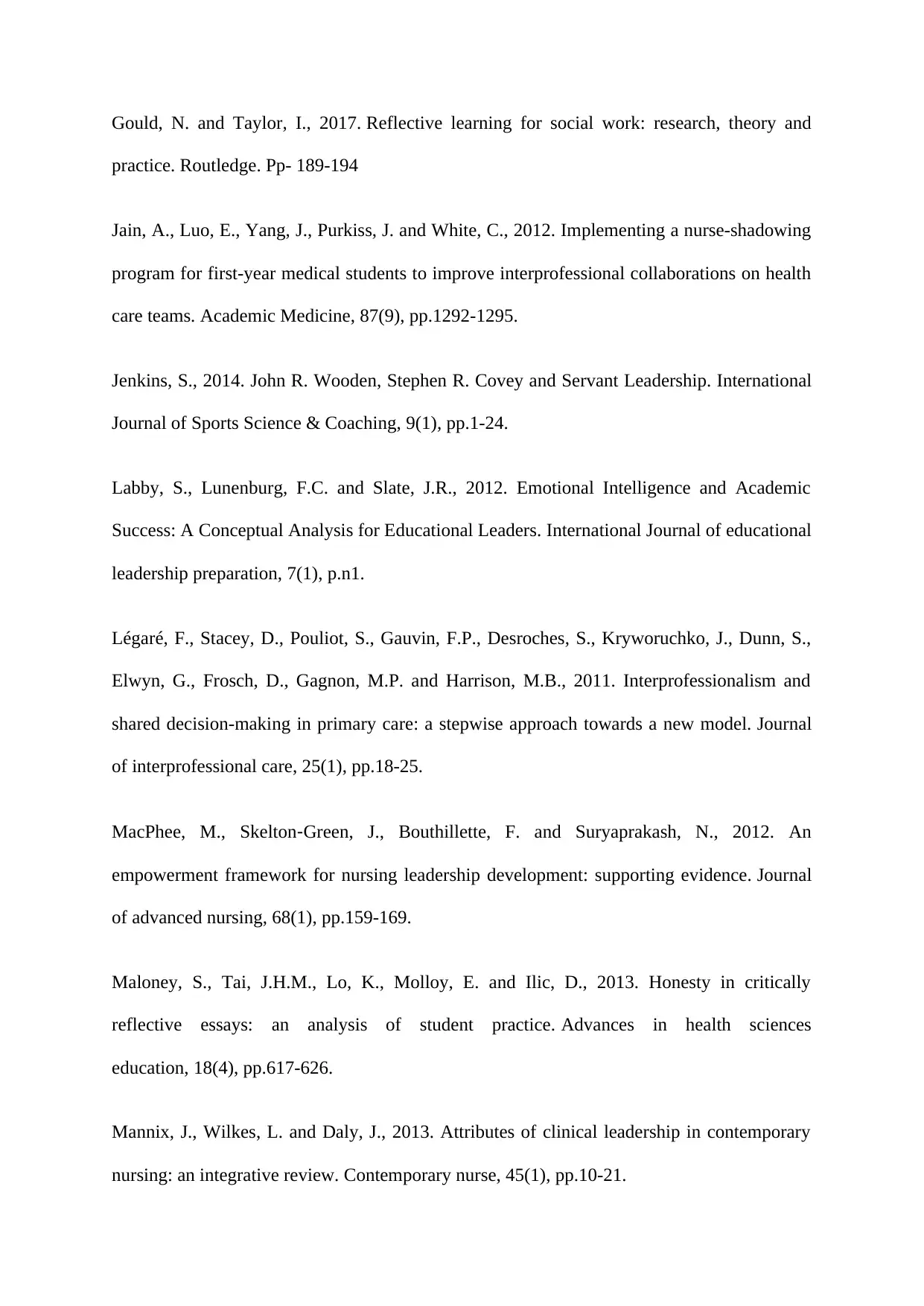
Gould, N. and Taylor, I., 2017. Reflective learning for social work: research, theory and
practice. Routledge. Pp- 189-194
Jain, A., Luo, E., Yang, J., Purkiss, J. and White, C., 2012. Implementing a nurse-shadowing
program for first-year medical students to improve interprofessional collaborations on health
care teams. Academic Medicine, 87(9), pp.1292-1295.
Jenkins, S., 2014. John R. Wooden, Stephen R. Covey and Servant Leadership. International
Journal of Sports Science & Coaching, 9(1), pp.1-24.
Labby, S., Lunenburg, F.C. and Slate, J.R., 2012. Emotional Intelligence and Academic
Success: A Conceptual Analysis for Educational Leaders. International Journal of educational
leadership preparation, 7(1), p.n1.
Légaré, F., Stacey, D., Pouliot, S., Gauvin, F.P., Desroches, S., Kryworuchko, J., Dunn, S.,
Elwyn, G., Frosch, D., Gagnon, M.P. and Harrison, M.B., 2011. Interprofessionalism and
shared decision-making in primary care: a stepwise approach towards a new model. Journal
of interprofessional care, 25(1), pp.18-25.
MacPhee, M., Skelton‐Green, J., Bouthillette, F. and Suryaprakash, N., 2012. An
empowerment framework for nursing leadership development: supporting evidence. Journal
of advanced nursing, 68(1), pp.159-169.
Maloney, S., Tai, J.H.M., Lo, K., Molloy, E. and Ilic, D., 2013. Honesty in critically
reflective essays: an analysis of student practice. Advances in health sciences
education, 18(4), pp.617-626.
Mannix, J., Wilkes, L. and Daly, J., 2013. Attributes of clinical leadership in contemporary
nursing: an integrative review. Contemporary nurse, 45(1), pp.10-21.
practice. Routledge. Pp- 189-194
Jain, A., Luo, E., Yang, J., Purkiss, J. and White, C., 2012. Implementing a nurse-shadowing
program for first-year medical students to improve interprofessional collaborations on health
care teams. Academic Medicine, 87(9), pp.1292-1295.
Jenkins, S., 2014. John R. Wooden, Stephen R. Covey and Servant Leadership. International
Journal of Sports Science & Coaching, 9(1), pp.1-24.
Labby, S., Lunenburg, F.C. and Slate, J.R., 2012. Emotional Intelligence and Academic
Success: A Conceptual Analysis for Educational Leaders. International Journal of educational
leadership preparation, 7(1), p.n1.
Légaré, F., Stacey, D., Pouliot, S., Gauvin, F.P., Desroches, S., Kryworuchko, J., Dunn, S.,
Elwyn, G., Frosch, D., Gagnon, M.P. and Harrison, M.B., 2011. Interprofessionalism and
shared decision-making in primary care: a stepwise approach towards a new model. Journal
of interprofessional care, 25(1), pp.18-25.
MacPhee, M., Skelton‐Green, J., Bouthillette, F. and Suryaprakash, N., 2012. An
empowerment framework for nursing leadership development: supporting evidence. Journal
of advanced nursing, 68(1), pp.159-169.
Maloney, S., Tai, J.H.M., Lo, K., Molloy, E. and Ilic, D., 2013. Honesty in critically
reflective essays: an analysis of student practice. Advances in health sciences
education, 18(4), pp.617-626.
Mannix, J., Wilkes, L. and Daly, J., 2013. Attributes of clinical leadership in contemporary
nursing: an integrative review. Contemporary nurse, 45(1), pp.10-21.
⊘ This is a preview!⊘
Do you want full access?
Subscribe today to unlock all pages.

Trusted by 1+ million students worldwide
1 out of 13
Related Documents
Your All-in-One AI-Powered Toolkit for Academic Success.
+13062052269
info@desklib.com
Available 24*7 on WhatsApp / Email
![[object Object]](/_next/static/media/star-bottom.7253800d.svg)
Unlock your academic potential
Copyright © 2020–2025 A2Z Services. All Rights Reserved. Developed and managed by ZUCOL.





